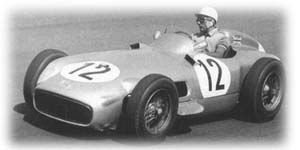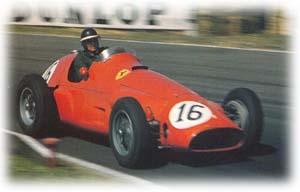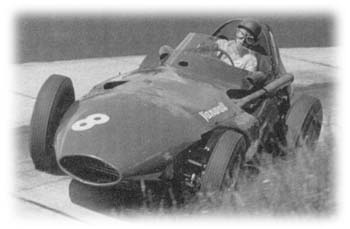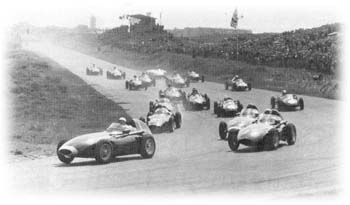|
1950
The first World Championship for Drivers under the jurisdiction of the FIA (Federation Internationale de l'Automobile) is contested.
The World Championship uses cars running to the stipulations laid out in the "Formula One" approved by the FIA in 1947: a maximum capacity of 4,500 cc for unsupercharged engines or 1,500 cc for supercharged engines.
First race of the World Championship is the British Grand Prix, on the Silverstone circuit - a former millitary airfield. Giuseppe Farina in an Alfa Romeo wins the race.
The Indianapolis 500 is included as round in the FIA World Championship.
First rear-engined car in a World Championship event makes its appearance at the Grand Prix of Monaco: a Cooper-JAP driven by Harry Schell.
Giuseppe Farina is the first World Champion.
 1951 1951
Scuderia Ferrari, with Argentinian driver Froilan Gonzalez at the wheel, achieve its first victory in a World Championship event, winning the R.A.C. British Grand Prix at Silverstone.
Juan Manuel Fangio, driving an Alfa Romeo, wins the World Championship.
BRM makes its World Championship debut as a constructor.
Alfa Romeo withdraws from F1 at the end of the season.
 1952 1952
Lack of support for Formula One by race organizers leads to World Championship being run using Formula 2 cars; Formula 2 stipulated a maximum capacity of 2,000 cc unsupercharged.
Alberto Ascari, driving an F1 Ferrari, participates in the Indianapolis 500.
All rounds in the World Championship, save for the Indianapolis 500, are won by Scuderia Ferrari.
Juan Manuel Fangio, as the result of broken neck in a pre-season race at Monza, sits out the season.
Alberto Ascari, driving a Ferrari, is World Champion.
 1953 1953
First South American round in the World Championship, the Grand Prix of Argentina, is held on the Buenos Aires circuit. The event is so popular, more spectators than the venue could hold show up. Many sit right at the edge of the track, and the inevitable occurs - at least 15 spectators and many others are injured as a result of a crash.
Maserati, with Juan Manuel Fangio driving, wins its first World Championship event in the final race of the season at Monza.
Formula 2 ends and is not replaced.
Alberto Ascari retains the World Championship.
1954
New Formula One for Grand Prix cars begins: maximum capacity of 2,500cc for unsupercharged engines and 750cc for supercharged engines.

The Maserati 250F makes its Grand Prix debut at the Argentinian Grand Prix.
Juan Manuel Fangio wins the first race run to the new formula, the Argentinian Grand Prix.
Mercedes-Benz re-enters racing, winning its first event back, the French Grand Prix at Reims.
Froilan Gonzalez, driving a Ferrari, defeats Mercedes-Benz at the British Grand Prix.
Lancia re-enters Grand Prix racing at the Spanish Grand Prix.
Juan Manuel Fangio, driving for both Maserati and Mercedes-Benz, wins the World Championship.
 1955 1955
Alberto Ascari becomes the first driver to plunge into the harbor at Monte Carlo during an event while driving his Lancia. However, days after his crash at Monaco, Ascari is killed when a tyre deflates on the Ferrari sports car he is driving at Monza. As a result of Ascari's death, and increasing financial problems, Lancia withdraws from Grand Prix racing.
Bill Vukovich is killed in a crash while leading the Indianapolis 500.
Fiat buys the assets of the Lancia Grand Prix team and presents it to Scuderia Ferrari, along with a stipend to support the team.
A Mercedes-Benz sports car, driven by Frenchman Pierre Levegh, crashes into a grandstand area in front of the pits at Le Mans, killing 81 spectators and injuring hundreds more.  Mercedes-Benz withdraws from the race. Mercedes-Benz withdraws from the race.
As a result of the Le Mans accident, the Grands Prix of France, Switzerland and Germany are cancelled, along with many other races; Switzerland bans circuit racing as a result.
Stirling Moss wins his first World Championship event, the British Grand Prix at Aintree, while driving a Mercedes-Benz.
Mercedes-Benz withdraws from Grand Prix racing at the end of the season.
Juan Manuel Fangio wins his third World Championship.
1956
Ferrari use cars received from Lancia as the basis of their team.
Vanwall introduce new car with a Colin Chapman designed chassis, and bodywork by Frank Costin.
 During the Italian Grand Prix, Peter Collins gives his car to Juan Manuel Fangio, forfeiting any opportunity of winning the Championship.
Stirling Moss, driving a specially built offset Maserati 250F, wins the Italian Grand Prix.
Ferrari experience tyre troubles for most the season with its the Engelbert tyres. Their failure at Monza leads to some spectacular crashes.
Juan Manuel Fangio wins his fourth World Championship while driving for Ferrari.
Seizure of Suez Canal in late 1956 results in fuel shortages in Britain and France, and racing is curtailed into the next year.
 1957 1957
Maserati produces a revised 250F and Juan Manuel Fangio returns to the team.
A Vanwall, shared by Tony Brooks and Stirling Moss, gives Britain its first win by a British constructor by winning the British Grand Prix at Aintree.
Fangio has what he describes as his greatest drive during the German Grand Prix.
Pescara, the longest circuit ever used for a Championship event (25.5 km), hosts its only Championship Grand Prix.
Juan Manuel Fangio wins his fifth World Championship.
1958
The Grand Prix formula, now extended to the end of 1960, now stipulates the use of AvGas in the place of alcohol fuels and reduces the length of Championship events from 500 km or three hours to 300 km or two hours.
 At the season-opening Argentinian Grand Prix, Stirling Moss gives Cooper its first win in a World Championship event and is also the first Championship win for a rear-engined car, a private entrant (Rob Walker), and the Coventry Climax engine.
Maurice Trintignant, using the same Cooper-Climax as Moss at the Argentinian Grand Prix, wins the second consecutive Championship race for the Rob Walker team, the Monaco Grand Prix.
Juan Manuel Fangio, at the wheel of a Maserati, runs his final World Championship event, the French Grand Prix at Reims.
Luigi Musso is killed during the French Grand Prix when his Ferrari crashes.
Peter Collins is killed during the German Grand Prix at the Nurburgring when his Ferrari crashes and hits a tree. the German Grand Prix at the Nurburgring when his Ferrari crashes and hits a tree.
Stuart Lewis-Evans dies from injuries and burns received while crashing during the final Championship event of the season, the Grand Prix of Morocco at Casablanca.
Mike Hawthorn wins the World Championship by a margin of one point over Stirling Moss.
Vanwall wins the first Manufacturers' Championship, but withdraws from Grand Prix racing.
World Champion Mike Hawthorn retires from racing.
1959
Mike Hawthorn dies in a road accident.
Rear-engined Grand Prix cars begin to replace the front-engined cars on the starting grids.
 Jack Brabham wins his first Championship event, the Grand Prix of Monaco.
Stirling Moss is now driving for private entrant Rob Walker.
The German Grand Prix is held for the first and only time at the AVUS circuit in Berlin and is run in two heats.
Jean Behra is killed when his car crashes during a support race for the German Grand Prix.
Bruce McLaren becomes the youngest driver to win a Championship event when he triumphs at the United States Grand Prix at Sebring.
Jack Brabham wins his first World Championship.
Cooper-Climax wins the Manufacturers' Championship.
|



 1951
1951
 1952
1952
 1953
1953

 1955
1955
 Mercedes-Benz withdraws from the race.
Mercedes-Benz withdraws from the race.

 1957
1957

 the German Grand Prix at the Nurburgring when his Ferrari crashes and hits a tree.
the German Grand Prix at the Nurburgring when his Ferrari crashes and hits a tree.
